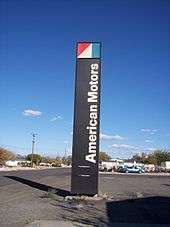AMC Rebel
| AMC Rebel | |
|---|---|
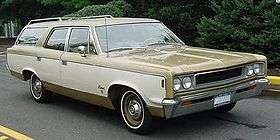 1968 AMC Rebel 770 station wagon | |
| Overview | |
| Manufacturer | American Motors Corporation |
| Also called | |
| Production | 1967 – 1970 |
| Assembly |
|
| Body and chassis | |
| Class | Mid-size |
| Body style |
|
| Layout | FR layout |
| Platform | AMC’s “senior cars” |
| Related | AMC Ambassador |
| Powertrain | |
| Engine |
|
| Transmission |
3-speed manual 3-speed with overdrive 4-speed manual 3-speed automatic 3-speed “Shift-Command” on console |
| Dimensions | |
| Wheelbase | 114 in (2,896 mm) |
| Length |
|
| Width | 77.29 in (1,963 mm) |
| Height | 53.5 in (1,359 mm) |
| Curb weight | 3,500 lb (1,588 kg) approx. |
| Chronology | |
| Predecessor | Rambler Classic |
| Successor | AMC Matador |
The AMC Rebel (known as the Rambler Rebel in 1967) is a mid-size car produced by American Motors Corporation (AMC) from 1967 to 1970. It replaced the Rambler Classic. The Rebel was replaced by the similar AMC Matador for the 1971 model year. The Rebel was positioned as the high-volume seller in the independent automaker's line of models.
The Rebel was available in several specialty models that included a limited number of station wagons with special themed trim and luxury equipment that were offered only in certain geographical areas. A high-performance, low-priced muscle car version was produced in 1970, the Machine, that is most recognized in its flamboyant white, red, and blue trim.
The Rebel is the shorter wheelbase 'intermediate-size' version of the longer wheelbase 'full-size' Ambassador line.
For the U.S. and Canadian markets, the Rebel was built at AMC's West Assembly Line (along with the Ambassador) in Kenosha, Wisconsin, and in Brampton, Ontario, Canada (Bramalea - Brampton Assembly Plant).
The Rebel was also assembled from complete knock down (CKD) kits under license in Europe (by Renault), in Mexico (by Vehiculos Automotores Mexicanos), in Australia (by Australian Motor Industries),[1] and in New Zealand (Campbell Motor Industries in Thames). Despite the Rambler name being discontinued on the Rebel in the North American market after the 1967 model year, Rebels continued to be sold in international markets under the "Rambler" brand name.
Background

The "Rebel" name was introduced by AMC in 1957 as a special model with a big V8 engine: the Rambler Rebel, the first factory-produced lightweight muscle car,[2] and the first hint that muscle cars would be part of the company's future.[3]
The Rebel name reappeared in 1966 on the top-of-the-line version of the Rambler Classic two-door hardtop. It featured bucket seats, special trim, and a revised roofline. For 1967, AMC's entire intermediate line took the Rebel name.
The new Rebel models were designed under the leadership of Roy Abernethy, but the automaker changed management with Roy D. Chapin, Jr. as chairman and CEO was trying hard to change AMC's frumpy image.[4] The redesigned intermediate line began to be promoted with a focus on performance and print advertising as one of the "now" cars, as well as having numerous factory and dealer installed high-output options.
During its production from 1967 to 1970, the Rebel was available as a six-passenger four-door sedan, and two-door hardtop, and a four-door station wagon with an optional third row seat for two more passengers. In addition, a two-door sedan (coupé) with a thin B-pillar and flip out rear side windows was available in 1967 only, and a convertible was offered in 1967 and 1968.
The six-cylinder engines that were introduced by AMC in 1964 were continued. However, the 1967 Rebel models introduced the first of a family of all-new V8s that replaced AMC's long-lived "Gen-1" designs in the mid-sized automobile market segment. These included the 290 cu in (4.8 L) and 343 cu in (5.6 L) engines that debuted in the 1966 Rambler American. With a four-barrel carburetor and dual exhaust, the 343 V8 produced 280 hp (209 kW; 284 PS) at 4800 rpm and 365 pound force-feet (495 N·m) of torque at 3000 rpm. The new Rebels also eliminated the torque tube design used in the Rambler Classic in favor of an open drive shaft with a four-link, trailing-arm rear live axle rear suspension system to provide a more comfortable coil spring ride.[5] The independent front suspension continued to use AMC's unequal-length control arms and high-mount coil springs.
1967
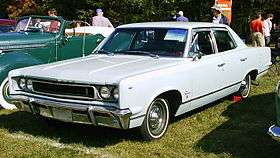
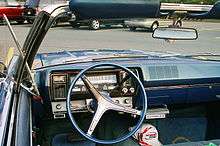
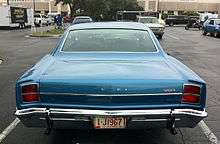
The 1967 Rambler Rebel by American Motors was completely new design from its predecessor, the Rambler Classic. Now a larger car riding on a two-inch (50 millimeter) longer 114-inch (2,896 mm) wheelbase, the width was also increased by nearly four inches (100 millimeters) to enlarge interior passenger space and cargo capacity. The Rebel had as much interior space as full-size cars from Ford and GM. The new body design was in sharp contrast to its predecessor's "straight-edge" design. The Rebel featured a smooth rounded appearance with sweeping rooflines, a "Coke-bottle" body with a shorter rear deck, as well as greater glass area for increased visibility. However, the design "themes" such the "hop up" fenders became so pervasive across the industry that the all-new 1967 Rebel was criticized because "viewed from any angle, anyone other than an out-and-out car buff would have trouble distinguishing the Rebel from its GM, Ford, and Chrysler Corp. competition."[6] American Motors was staying abreast of the fashion and the Rebel was the first "family car with style that rivaled function."[7]
A new safety-oriented instrument panel featured a steering column designed to collapse under impact, and the gauges and controls were grouped in a hooded binnacle front of the driver with the dashboard pushed forward and away from the passengers.
The Rebel models were similar to the senior Ambassador in that they shared the same basic unit body (platform) aft of the cowl. However, the Rebel's front end saw an entirely new concept with a "venturi" grille motif in die cast metal while its rear end featured a simple design with inward-curved taillights. Rebels came in the base 550 and deluxe 770 models, with a high-line SST available only as a two-door hardtop.
The base 550 two-door sedan featured the identical "semi-fastback" roofline as the more expensive pillar-less hardtops, but had slim B-pillars that gave them a more "sporty"coupe appearance. The convertible featured a new "split stack" folding mechanism design that allowed a full-width backseat with room for three passengers. The four-door sedans continued a traditional notchback form, albeit smoothed from the previously sharp angled roofline. The Cross Country station wagons featured a standard roof rack, all vinyl upholstery, and a drop down tailgate for carrying long loads. A third, rear-facing seat was optional with a side hinged tailgate for easier access. The Rebel 770 wagon was available after mid-year production with 3M's DI-NOC simulated wood-grain body side panels trimmed in a slim stainless steel frame.
Starting with the 1967 models, American Motors offered the industry's most comprehensive warranty up to that time: two-years or 25,000 miles (40,000 km) on the entire automobile, as well as five-years or 50,000 miles (80,000 km) on the engine and power train. American Motors continued its industry exclusive ceramic-coated exhaust system as standard.[8]
To further emphasize the durability and prove the reliability of the new Rebels, an absolute record of 30 hours flat was set in the long-distance Baja run down Mexico's Baja California Peninsula in 1967.[9] A hole in the transmission pan slowed them down, but the endurance racers were able to get the car to a town to get a new one.[10]
Offering traditional Rambler economy with six-cylinder engines and overdrive transmissions, the Rebel could also be turned "into a decent budget-priced muscle car" with the 343 cu in (5.6 L), the largest available engine in 1967.[11] A road test by Car Life magazine of a Rebel SST hardtop equipped with the 343 V8 and automatic transmission turned in a 0-60 mph (0 to 97 km/h) time of nine seconds, and reached a top speed of 110 miles per hour (177 km/h). A road test by Popular Science found similar performance times and noted that their Rebel SST was the quietest-riding of the tested cars, but with the drawback of wind noise.[12] The magazine also praised Rebel's reclining backrests for both front seats that reduce fatigue on long trips while a co-driver can stretch out and relax, as well as AMC's self-tightening seat belts that aid in buckling and in comfort.[13] A survey conducted by Popular Mechanics after owners had driven their cars 678,996 miles (1,092,738 km) concluded: "in all, the report indicates that most Rebel owners are delighted with their purchases." [14] Journalist and automobile critic, Tom McCahill, summarized his Mechanix Illustrated road test, "there isn't a better intermediate size car sold in the United States than the 1967 Rebel".[15]
1968
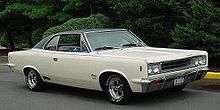

The 1968 model year Rebels were introduced on 26 September 1967, and were no longer a Rambler in name.[16] The mid-sized models were now the AMC Rebel, but little was changed except for additional safety features. For ten years AMC "strictly observed the auto industry's anti-racing resolution" but management changed and the AMC Rebel began to be campaigned on the dragstrips.[17] The top-of-the-line model SST came standard with the 290 cu in (4.8 L) "Typhoon" V8 while all the other models were available with the 232 cu in (3.8 L) I6 engine.
The 1968 models were treated to a modest restyle of the trim, grille, and taillamps. New mandates by the Federal Motor Vehicle Safety Standards for all 1968 model passenger cars were incorporated. Safety equipment including separate shoulder harness for the front seat belts, two rear lap belts, lighted side markers, padded seat backs, non-glare finish, safety design handles and armrests, energy absorbing steering column and optional headrests.[18] American Motors did not wait for the requirements to cars delivered to dealers after 31 December 1967, but incorporated the safety features starting with the early 1968 model year cars produced in late 1967. Other requirements caused increases to the price of all cars manufactured after 1 January 1968, including exhaust control systems to help reduce unburned hydrocarbon and carbon monoxide emissions.[19]
A new AMC safety and styling feature was also introduced on the 1968 Rebels; the flush-mounted paddle-style door handles. These replaced the former push-button design and become an enduring AMC signature on its passenger cars through 1988 and the Jeep Wrangler until 2006.
Also new for 1968 was the Rebel 550 Convertible, the last AMC convertible, which replaced the American.[20] The 550 was the base level convertible as the top trim version moved from 770 to the SST model joining the two-door hardtop. The two SST body styles featured more trim and features that included individually adjustable and reclining front seats, as well as simulated air-intakes ahead of the rear wheels. The interiors of AMC's Rebel made extensive use of a new olefin fiber carpeting.[21]
American Motors changed its advertising agency to Wells, Rich, and Greene, which was headed by Mary Wells Lawrence. The automaker wanted to attract the highly individualistic, "non-average buyer".[22] The new agency established innovative campaigns and promotions for AMC that emphasized value for the money in direct comparisons to the competition showing "elegantly coifed beauties swooping from swank settings into modest AMC Rebels just as contentedly as if the cars were Continentals. Meanwhile, an off-camera voice proclaims: 'Either we're charging too little for our cars or everyone else is charging too much.'"[23] The advertising was highly controversial because it violated the accepted rule of not attacking the competition.[24] This marketing was successful in bringing AMC back to the firm's economy and practical-car roots in customers' minds, which resulted in higher sales.
1969
.jpg)
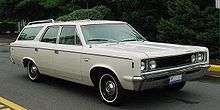
The 1969 model year saw elimination of the 550 and 770 models, as well as the convertible body style. The four-door sedan, station wagon, and two-door hardtop were now available in base and SST trim. The automaker was moving the Rebel line to a more "family-oriented" direction and only the two-door SST model received new simulated "louver" trim ahead of the rear wheel openings.[11]
Exterior changes included a new grille, wrap-around taillights, decklid, as well as trim and ornamentation. The front and rear track was increased from 59 in (1,499 mm) to 60 in (1,524 mm), but all other dimensions remained the same.[25]
The interior received a new deeply hooded instrument panel with clustered instruments and controls in front of the driver. The AMX 390 cid. 315 h.p.V8 introduced only in the 2-seat AMX mid year 1968 was made an option on on 1969 AMC's and was made available on the Rebel. A comparison of all domestic station wagons by Popular Mechanics noted that the intermediate-size models will not carry 4x8 foot plywood panels flat on the load floor, but described the "cargo space in the Rebel wagons is impressive" featuring 91.12 cu ft (2,580 L) of space.[26]
American Motors produced an innovative advertising campaign for the 1969 AMC Rebel that became one of the best TV commercials in one of 15 categories as selected by a team of experts.[27] Known as a builder of "Aunt Martha fuddy-duddy-type cars, but in the late 1960s, at the peak of America's love affair with the auto, AMC wanted to be jazzy."[27] It had previously taken a "totally rational approach" - such as describing the benefits of factory rust-proofing and long warranty coverage.[27] The goal of the new advertising was to highlight AMC's differences and "make an impact" with the car line.[27] Considered as "one of the funniest TV commercials of all time -- not just for cars" is the 1969 AMC Rebel that is torture-tested by student drivers.[28]
1970
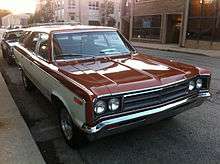
In 1970, the sedan and coupe received a restyled rear-end, along with a new C-pillar shape and rear quarters, as well as a more massive rear end and bumper. The hardtop was changed to a more sloping roofline with upswept reverse-angle quarter windows, giving them "a somewhat huskier look for 1970".[29] The taillights were integrated into a new loop rear bumper with Rebel spelled out between them. The four-door sedans also had an altered roofline with a slimmer C-pillar and larger, squared-off rear door windows. Similarly as on the coupe, the belt line kicked up beneath the trailing edge of the rear door windows, and then tapered back to the same rear fascia as on the hardtop. The Rebel sedans and hardtop models two inches (51 mm) longer than previously. The Rebel station wagons saw no change to their rooflines, doors, and rear fascias.
The grille was again revised with a horizontal spit in the middle and the name, Rebel, was spelled out on the left lip of the hood. The exterior trim, colors, and model identification locations were also modified for 1970. Rebels were available in base or SST trim. The effect of the changes was summarized by the Auto Editor of Popular Mechanics, "the Rebel has a 'no nonsense' air about it I find appealing.[30]
Safety changes included "clam shell" bucket seats with high backed integrated head restraints. The side structure of the 4-door sedans and 2-door hardtops was made stronger.[31] While the competition from the domestic "Big Three" automakers were increasing in size, the Rebel was smaller and lighter, with a six-cylinder manual 2-door hardtop weighing in at 3,110 lb (1,411 kg) and a V8 automatic station wagon at 3,310 lb (1,501 kg)[31]
A major change was to the available V8 engines. The standard 290 cu in (4.8 L) V8 was replaced for 1970 by a new 304 cu in (5.0 L) 210 hp (157 kW; 213 PS) while the 343 cu in (5.6 L) was also supplanted by a 360 cu in (5.9 L). The 360 V8 was available with a 2-barrel carburetor producing 245 hp (183 kW; 248 PS) or in a 4-barrel version producing 290 hp (216 kW; 294 PS).[32] The "AMX" 390 cu in (6.4 L) engine now produced 325 hp (242 kW; 330 PS) and was optional on SST models, while a special high-performance 340 hp (254 kW; 345 PS) version was standard on The Machine. This was the most powerful engine AMC would ever offer in a regular production vehicle. The center console mounted floor-shift automatic transmission cars received a "pistol-handle" shaped grip.
A Popular Science road test comparing six-cylinder intermediate-sized 4-door sedans (Chevrolet Malibu, Ford Torino, and Plymouth Satellite) reported that the Rebel 770 was the quietest, offered the most interior space and trunk room, "yet burns less gas than the others."[33] A Popular Mechanics nationwide survey based on 316,000 of owner-driven miles (508,553 km) found that style, handling, and comfort abound, but so do minor rattles.[34] The 304 cu in (5.0 L) V8 engine was selected by almost 87% of owners for its combination of performance and durability. The AMC Rebels also excelled "in freedom from mechanical troubles and workmanship complaints" with the magazine noting that owners took "delivery of perfectly-put-together cars - quire a remarkable feat."[34]
The 1970 restyle lasted only one year before a further restyle and renaming the models as the AMC Matador. The four-door and wagon platform would remain unchanged until the retirement of the Matador line after the 1978 model year.
Regional models
Station wagons
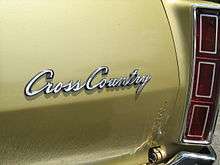
All regular Rebel station wagons were called Cross Country by AMC. During the 1967 model year, AMC issued a series of specialty Rebel station wagons with luxury equipment.[35] Designed to spur interest in all of AMC's products and to generate increased sales for the company, the special wagons were limited for sale to geographical areas.[36] According to automotive historian James C. Mays, the regional wagon marketing program was a success and it contributed to increasing confidence among the public in the "feisty" automaker.[36]
Standard equipment on all regional wagons included 290 cu in (4.8 L) V8 engine (the 343 cu in (5.6 L) was optional), automatic transmission, power steering, power drum brakes, as well as special duty springs and shock absorbers.[37] Each featured a distinctive interior and exterior trim:
- The Mariner (600 units) in Barbados Blue paint with body side panels and rear tailgate trimmed in simulated bleached teak wood planking accented by narrow black horizontal stripes and a "nautical anchor" medallion. The interior featured anchors and stars decorating dark blue suede bolster panels of the seats, which also had white piping and broad horizontal pleated inserts of medium blue antelope grain vinyl. The Mariner was sold along the coastal regions of the United States.[35]
- The Briarcliff (400 units) in Matador Red paint with simulated black camera grain body side panels and "regal" medallions, as well as its own black "antelope grain" vinyl interior. The Briarwood was marketed in major markets in the east and south.[35]
- The Westerner (500 units) in Frost White paint with wood plank trim side inserts for the body side and tailgate, as well as a "Pony Express" medallion. The interior featured stallion brown vinyl that simulated "richly tooled" leather on the seats and door panels in combination with white antelope grained vinyl. The Westerner was available west of the Mississippi River.[35]
Each version included the color-coordinated upholstery and door panels, individually adjustable reclining seats, sports steering wheel, as well as the 91 cubic feet (2.6 m3) of carpeted cargo room, a locking hidden compartment, and a roof rack. Special regional nameplates were on the rear fender in addition to the unique medallions on the C-pillar.[37]
Raider
In 1969, a Rebel Raider two-door hardtop was sold only in New York and New Jersey. The marketing of these cars was timed to coincide with the New York City Auto Show. Three hundred Raiders were built and many were part of a “driveaway” by area dealers on the eve of the Auto Show.[38] All Raiders came with a V8 engine with automatic transmission, as well as “blow-your mind colors to choose from: electric green, tangerine, and blue-you’ve never seen.”[39] This was a test market of the “Big Bad” colors by AMC through a regional dealer-lead promotional campaign.[40] The bright hues were later introduced at mid-year on the Javelin and AMX models.[41] Other standard features on the Raider included black upholstery and carpeting, black front grille, black vinyl roof, a sports-type steering wheel, AM radio, power steering, and power brakes. The total price of the special Raider models was advertised at US$2,699.[39]
Rebel funny cars

Under the leadership of Roy Abernethy, AMC observed both the letter and spirit of the resolution prohibiting automakers from sponsorship in automobile racing.[42] It was instituted by the Automobile Manufacturers Association (AMA) in 1957.[43] As Rambler's sales reached third place in the domestic marketplace, AMC continued to advertise the only race the company was interested in was the human race.[44] However, with AMC’s precarious financial condition in 1966 following the race to match its "Big Three" domestic competitors under Roy Abernethy, the new management reversed AMC's anti-racing strategy and decided to enter motorsports as a method to gain exposure, publicity, and a performance image.
American Motors' Performance Activities Director Carl Chamakian was charged to get AMC automobiles in racing, which would help to attract a younger customer base.[45] In a “quest for quarter-mile glory,” AMC reached a $1 million (US$7,108,782 in 2015dollars[46]) agreement in 1967 with Grant Industries in Los Angeles, California (a manufacturer of piston rings, ignition systems, and steering wheels), to build the Grant Rambler Rebel, a "Funny Car" racer to compete in the National Hot Rod Association (NHRA) X/S (Experimental Stock) and Super Experimental Stock classes.[45]
When asked why the company decided to work with AMC, Grant’s President, Grant McCoon responded, “Rambler is a good automobile, and it's time somebody proved what it can do.”[45] The relationship provided both companies with national exposure and publicity. The car had an altered wheelbase 122-inch (3,099 mm) RCS (chrome moly steel) tube chassis with a 343 cu in (5.6 L) AMC V8 engine that was bored and stroked to 438 cu in (7.2 L) tuned by Amos Saterlee.[47] With its GMC 6-71 blower and Enderle fuel injection, the motor produced 1,200 hp (895 kW; 1,217 PS) winding up to 9000 rpm on a mixture of alcohol and nitromethane.[45] Starting in June 1967, the car was driven by "Banzai" Bill Hayes and painted red featuring a blue racing stripe with white stars. Soon, Hayden Proffitt took over the Grant funny car program and ran the Rebel on the quarter-mile (402 m) from a standing start in 8.11 seconds at 180.85 mph (291.0 km/h).[48]
For the 1968 season, a new car was built and renamed the Grant Rebel SST and painted in the new hash red, white, and blue AMC corporate racing colors.[45] With Hayden piloting, the car consistently ran the dragstrip in the mid-eight second range at speeds around 180 miles per hour (290 km/h).[45] By the end of 1968, AMC dropped out of funny car racing to concentrate on its new Javelin pony car in SCCA Trans Am road racing, while Proffitt retired from racing for a few years.[47]
In 1968, Ron Rosenberry drove the King Rebel of Ted McOsker using a blown fuel Chrysler Hemi engine and had a known best of 9.58 seconds at 148.02 mph (238.2 km/h) in the quarter mile dragstrip.[47]
The Machine
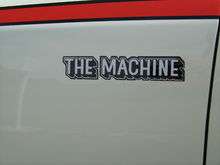
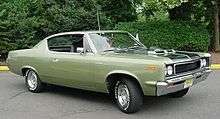

The most recognizable muscle car version of the AMC Rebel was named The Machine and available for the 1970 model year, following the success of the 1969 SC/Rambler.[49] In its most patriotic or flamboyant factory trim The Machine was painted white featured bold red, white, and blue reflective stripes (made by 3M) on the bodysides that wrapped over the trunk lid.
Concept muscle models
First proposed in June 1968, the car was to have been a 1969 Rebel coupe finished in black with authoritative black wheels and fat tires, without any stripes, scoops, or spoilers, but with an aggressive, street-fighting stance.[50] The proposed model included "The Machine" decal on the rear (that made it into production), as well as a "fab gear" logo on the front fender.[51]
However, an even earlier attempt at a Rebel-based muscle car was produced by the AMC's engineering team: a 1967 two-door built as a development "project" car for carburetion-testing purposes, as well as with "Group 19" high-performance options and the car was re-equipped with a modified 390 cu in (6.4 L) engine with an estimated 500 hp (373 kW; 507 PS) "capable of running in the 11-second bracket."[52] The car was considered a legal drag racing car, according to National Hot Rod Association (NHRA) and American Hot Rod Association (AHRA) rules and regulations in effect during those years.[52] The Machine was finished in AMC's trademark red, white and blue color scheme, although the color breaks were not the same as on other AMC-backed or developed race cars.[52]
Performance features
American Motors' high performance "halo" vehicle made its official debut 25 October 1969, in Dallas, Texas; the site of the National Hot Rod Association's World Championship Drag Race Finals. The Rebel Machine was factory rated at 10.7 pounds per horsepower, positioning the car for the NHRA F-stock class.[53] The introductory marketing campaign consisted of ten vehicles (five with automatics and five with four-speed manuals) that were driven from the factory in Kenosha, Wisconsin to Dallas, Texas and raced in the condition they arrived in. There were four cars on the track "in bone-stock trim" that ran solid mid-14s during the press day at the now-defunct Dallas International Motor Speedway.[54] All these cars were subsequently campaigned at numerous other drag strips, and subsequently sold as used vehicles according to AMC corporate policy.[55] The automaker's marketing objective was for each AMC dealer to have one colorful Rebel Machine on display in their showrooms to lure non-AMC potential customers so they could be introduced to the other models. The most successful dealers actually raced the cars at local drag strips.
The Machine was developed from a collaboration between Hurst Performance and AMC, but unlike the compact SC/Rambler, there was no official connection between the two parties once production commenced.[49] The standard engine in The Machine was AMC's 390 cu in (6.4 L) V8 engine with 340 hp (254 kW; 345 PS) and 430 lb·ft (583 N·m) of torque @ 3600 rpm. It came with special heads, valve train, cam, as well as a redesigned intake and exhaust.[56] This was the most powerful in any AMC vehicle while retaining features required for normal street operations, as well as components to assure outstanding performance characteristics without incurring high-unit cost penalties.[57] The engine is fed by a 690-cfm Motorcraft 4-barrel carburetor, and pumped up a 10.0:1 compression requiring high-octane gasoline.[58]
The Machine features a large ram-air intake hood scoop that was painted Electric Blue (code B6) with a large tachometer visible to the driver integrated into a raised fairing at the rear of the scoop. This hood-mounted tach came from the same vendor as used on competing makes with only different dial faces. Early production hood scoops were fiberglass layups, while those installed on Machines after 1 January 1970 were injection molded and of higher quality. The heavy-duty suspension was augmented by station wagon springs in the rear (with higher load rating) giving the car a raked look. Standard were a Borg-Warner T-10 four-speed manual transmission with a Hurst floor shifter backed by either 3.54:1 or 3.91:1 rear axle gear ratios in the "Twin-Grip" differential, as well as power disc brakes, wide E60x15 Goodyear Polyglas white letter tires mounted on "Machine" mag-styled steel 15-inch (381 mm) x 7-inch (178 mm) wheels, and a black interior with bucket seats and a center armrest upholstered in red, white, and blue vinyl.
Machine wheels
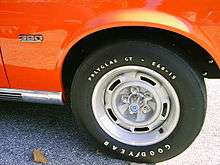
Among its standard performance features, all The Machine models included a special set of wheels with the appearance of a cast alloy wheel. Painted silver metal-flake with a rough texture, they have a mag-style appearance. AMC described them as "15-inch styled road wheels" in brochures and catalogs.[59] Enthusiasts call them "Machine wheels" and the wheel's came with a chrome center cap adorned with a blue trim disc featuring a gear icon in the center and the words American Motors around it.[60] The 15-inch (381 mm) x 7-inch (178 mm) wheels made by Kelsey-Hayes. They have five narrow cooling slots positioned atop risers stamped around the center of the wheel. The trim ring is unusual because it does not overlap the rim (to allow for attaching wheel balancing weights) and it is permanently press-fit.[59]
The "Machine" wheels were also optional on the 1970 AMX and Javelin models through the 1972 model year, as well as part of the "Go-Package" on 1971 and 1972 Javelin AMXs, after which a more conventional 15x7-inch slotted steel rally wheel replaced it.[61]
Marketing
Advertisements in magazines such as Hot Rod teased that The Machine is not as fast as a 427 cu in (7.0 L) Chevrolet Corvette or a Chrysler Hemi engine, but it will beat a "Volkswagen, a slow freight train, or your old man's Cadillac.[62] Numerous upgrades were standard to make each Machine a potent turnkey drag racer. In contrast to the lack of options on the SC/Rambler, Machine buyers could order numerous extras from the factory.[63] These included substituting the manual for a center console mounted "pistol grip" automatic transmission for $188, adding cruise control cost $60, a adjustable tilting steering wheel cost $45, and even air conditioning was available for an additional $380.[56] Furthermore, American Motors dealers sold numerous performance parts over the counter, such as an incredibly steep 5.00:1 gearing "for hardcore drag-racer types."[64] An optional "service kit" for $500.00 increased horsepower to well over 400 hp (298 kW; 406 PS) and lowered its quarter mile drag strip times from 14.4 with the factory Autolite carburetor (and standard rear wheel hop behavior at maximum acceleration from standing) to 12.72 seconds.[65]
American Motors Vice-President for Sales, Bill Pickett described that the Rebel Machine was "another youth-oriented car."[56] The company described, "the supercar buyer is usually young, relatively affluent and has a "critical awareness" of exterior styling. At the same time he wants to be treated as an individual and stand out from the crowd. The Rebel Machine's distinctive paint job, rakish nose-down attitude and obvious performance characteristics lets the supercar buyer express his identity, or, in the words of today, 'Do your own thing'. Being different from the crowd today does not necessarily mean being against something, but rather in reinforcing certain specific ideas. We anticipate that the Machine will identify with this new brand of rebel, who demonstrates for something."[66] The automaker claimed in its marketing promotion that "The Machine is not that fast," but that the car was capable to "give many muscle cars from the big three (General Motors, Ford, and Chrysler) a run for their money".[64] According to a retrospective Motor Trend article, The Machine is the most strip-ready car of the group they tested.[67] The Machine could spring from zero to 60 miles per hour in just 6.4 seconds, a creditable showing even today.[68] The Machine's top speed was 127 mph (204 km/h).[64]
The manufacturer's suggested retail price (MSRP) price was $3,475 (US$21,210 in 2015 dollars[46]). After the initial run of 1,000 units with its distinctive and easily recognizable identity, The Machine was available without the stripes in other colors with a blacked out hood. A unique paint schemes for the Machine is Frost White with a flat-black hood (paint codes: 72A-8A), with only three made. Another exclusive version came in "Big Bad Green" with at least three made and possibly only one known factory documented original car remaining.[69] The original trim scheme became a $75 option. There were a total of 2,326 Rebel Machines built in 1970.[70] With the Machine "AMC had acquired a reputation for the ability to create eye-catching, high performance machines at a knock-down price."[71]
According to the former editor of Motor Trend magazine, before BMW took "The Ultimate Driving Machine" moniker for itself, American Motors dubbed its high-performance model that could hold its head high in fast company simply "The Machine" and it deserves to be considered among the Greatest Cars of All Time.[68]
The 'Machine' option was offered again as a package for the 1971 re-styled Rebel named Matador, as noted in 1971 AMC Technical Service Manual.
Convertibles
During the 1967 model year, American Motors produced a total of 1,686 Rambler Rebel convertibles; all in the top-trim SST model.[72] Automatic power operation of top was standard. The new convertible top design featured a "streamlined" look blending smoothly with the lower body with the top up. Its new "split stack" folding mechanism also allowed a lower stack height with the top folded down, as well as for a full-width backseat with room for three passengers.
For 1968, the Rambler name was dropped and two convertible versions were offered in the Rebel line. A total of 1,200 were produced (823 in the SST version and 377 units in the base 550 model).[73] Since convertibles in the Rambler American and Ambassador series were dropped after 1967, the 1968 Rebels were the only open models built by AMC.[74] This was also the last year for AMC convertibles until this body style was added to the compact Renault Alliance in 1985.[75]
Other markets
The AMC Rebel was produced under a number of business ventures in foreign markets. In these markets, "the Rebel was still the epitome of the modern mass-produced US sedan."[76]
Australia
.jpg)
4-door sedan and station wagon Rebels from CKD (Completely Knocked Down) kits were assembled by Australian Motor Industries (AMI) in Port Melbourne, Victoria. Australian models were made with a RHD version of the 1967 Rambler Ambassador dash and two-dial instrument pack rather than the North American dash and rectangular speedo. The dash and cluster were reused for all subsequent models, including the Matador. The cars were built with right-hand drive and the body had the engine, transmission, front suspension, rear axle, and doors installed in Kenosha, Wisconsin. Other parts were boxed and shipped inside the car for final assembly in Australia. Australian models had to have aftermarket amber rear indicator lights fitted in the boot (trunk) lid to 1969 and amber lenses fitted behind the clear reverse lenses on 1970 models, as flashing red indicators were barred in Australia. Also in Australia, numerous other parts and components such as brakes, seats, carpet, lights, heaters, etc. were sourced locally to gain tariff concessions.[77] As AMI also assembled Toyota vehicles, some parts used on the AMI Rebels were sourced from Toyota.[78]
After the Rebel was discontinued by AMC after 1970 Australia continued to assemble the 1970 Rebel throughout 1971 alongside the replacement 1971 AMC Matador sedan. Per AMI records, 307 1970 Rebels were newly registered in Australia in 1971. 2-door variants of the Rebel were not marketed in Australia.
Both the Rebel and the subsequent Matador were sold in Australia under the Rambler marque, despite AMC discontinuing the use of the name on the Rebel from the 1968 model year. The Matador was sold in Australia until 1977.
New Zealand
As with Australia, RHD four-door sedan and station wagon Rebels from CKD (Completely Knocked Down) kits were assembled by Campbell Industries (CMI) in Thames, New Zealand whom had assembled AMC vehicles since the 1960s.
New Zealand received its CKD kits from Canada, being a fellow Commonwealth country allowed for tariff concessions.[77]
As with the Australian-assembled models, New Zealand Rebels also reused the 1967 Rambler Ambassador dash and instrument pack for all model years. The cars were built at the AMC plant in Kenosha with right-hand drive with engine, transmission, front suspension, rear axle, and doors already installed. Other parts were boxed and shipped inside the car for final assembly in New Zealand. The New Zealand models were more "American" than the Australian models as Australian laws required more local content for tariff concessions. For example, New Zealand models came with the U.S seats, door cards, headlining and sun visors, whereas the seats, door cards, headlining, and sun visors on Australian models were all locally supplied. Australian Law prohibited the use of rear red turn signals, whereas these were allowed in New Zealand.
For the 1970 model New Zealand did not receive the new AMC 360 V8, only the 304 cu in (5.0 L) V8 whereas Australian 1970 models came with the 360 cu in (5.9 L) engine.
Although the Rebel ceased production at the end of 1970 in North America, New Zealand continued to assemble the 1970 Rebel throughout 1971 (as did Australia.) Production figures for NZ-assembled Rebels were: 1967: 228, 1968: 156, 1969: 136, 1970: 147, 1971: 100.[79] Additionally 177 cars were fully imported.
Europe

Under a partnership agreement that was developed in 1961 with the French automaker Renault, the Rebel's two-door hardtop was added for the first time to the traditional 4-door sedan body style of the Renault Rambler. The new for 1967 designs were assembled in Haren, Belgium and sold by Renault dealers in Algeria, Austria, Belgium, France, the Netherlands, and Luxembourg.[80]
The Rambler models served as the executive car in Renault's product line, but the entirely new design was larger car with more power than the previous Rambler Classic and no longer suitable for European automobile tax regimes or road conditions.[81] The 1967 models were priced 20 to 25% more than the previous year's; therefore, production ended in the summer of 1967.[81]
Business with Renault continued in Argentina when Industrias Kaiser Argentina (IKA) was bought out by Renault in 1975 to form Renault Argentina.[82] The IKA-Renault Torino was built on the same hybrid AMC platform from 1966 all the way through 1982.[83] The past ties with the French automaker contributed to further relationships.[84] A major agreement between AMC and Renault was announced in 1978 for the joint manufacture and distribution of cars and trucks in Europe, as well as the U.S. and Canada.[85] By the end of 1980, AMC shareholders approved making the French Government-owned Renault their company's principal owner.[86]
Mexico
American Motors had partial ownership of Vehiculos Automotores Mexicanos (VAM) and the Mexican operation produced equivalent AMC Rebel models. Mexican regulations required VAM vehicles had to have at least 60% locally sourced parts. The large-sized VAM cars in only two body styles, a two-door hardtop called the Rambler Classic SST, and a four-door sedan called the Rambler Classic 770 under license from 1967 through 1970, no other trim levels or designations were available. The car was VAM's entry in the luxury segment of the Mexican auto market in contrast with its other lines that focused on economy. The VAM Classic represented the company's flagship model, a treatment that in the United States was given to the AMC Ambassador models.
In addition to different model names and marketing concept, the Mexican versions also adapted AMC I6 engines to local conditions.[87] They also came with more upscale interiors compared their counterpart models sold in the United States and Canada. The standard engine was the 155 hp (116 kW; 157 PS) 232 cu in (3.8 L) I6 with two-barrel carburetor from 1967 through 1969, even though the Rambler Classic SST had the option of VAM's own 252 cu in (4.1 L) I6 early in 1969, which became standard equipment several months late in the year. Since 1970, both versions were equipped with VAM's 170 hp (127 kW; 172 PS) 252 cu in (4.1 L) I6 with two-barrel Carter carburetor, 9.5:1 compression ratio and 266 camshaft from the factory.[88] The cars were restricted to a three-speed manual transmission in 1967 and 1968, but were available with an optional column mounted three-speed automatic starting in 1969, making the Rambler Classic the second regular production VAM to offer an automatic transmission after the Javelin the year before. Rear gear ratios included a 3.73:1 for 1967 and a 3.54:1 for the remainder of the run. External cosmetic changes over the years in VAM Rambler Classics were mostly the same as in the U.S. and Canadian market Rebels.
Both VAM Rebel-based Rambler Classics included almost the same equipment between the two body styles with only a few exceptions. The largest difference was in the front seats. The Classic 770 came with full-width bench seat while the Classic SST had individually adjustable units, even though some of the hardtops came with a front bench. The standard features included flow-through ventilation, front door flip-open air vents, four-wheel drum brakes, rigid four-bladed cooling fan, day-night rearview mirror, two-speed electric wipers, electric washers, luxury steering wheel, electric clock, 200 km/h speedometer, cigarette lighter, front ashtray, AM Motorola radio with antenna, locking glove box, courtesy lights, dual rear ashtrays, four side armrests, front two-point seatbelts, dual coat hooks, dual dome lights on C-pillars (except 1969-1970 sedan), single dome light on headliner (1969-1970 sedan only), fold-down armrest integrated to the rear seat back, bright molding package, luxury wheel covers, back-up lights, turn lights, and driver's side remote mirror. Optional equipment for both models included power drum brakes (standard with automatic transmission), power steering, automatic transmission (not available in 1967 and 1968), remote controlled driver and passenger outside mirrors, heater with front defroster, rubber-faced bumper guards, bumper tubes, and a locking gas cap, among others. Sales the two-door hardtop body style declined in 1970.[89]
The Rebel-based Rambler Classic models in Mexico were never available as two-door sedans, two-door convertibles, or four-door station wagons. The Rebel Machine models were also not available under VAM, although an equivalent would come in 1972 in the form of the VAM Classic Brougham hardtop.
Name change
After evaluating the situation of social unrest within the U.S. and the model name's associated connotations of rebellion, "American Motors officials decided that it was no time to be selling a car called Rebel."[90] The automaker's marketing department conducted consumer research and determined a name change for the 1971 model year to Matador as marketing studies found it "meant virility and excitement to consumers."[90]
Collectibility
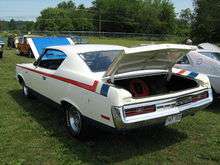
According to automotive historian James C. Mays, the 1967 limited edition regional Rambler Rebel station wagons became a collectible before their time.[36]
Among the 1968 to 1970 models, the 1968 Rebel convertible should gain in importance as the last of AMC's ragtops, and although station wagons and sedans later joined the SST hardtop, only the two-door models have collector appeal.[74] The Rebel's "clean but mundane styling" is a minus for collector appeal, but Carl Cameron, an automobile designer at Chrysler and developer of the original Dodge Charger fastback, mentioned that the best competitors during the late 1960s were the AMCs with new engines and the Rambler Rebels were "really nice, very hot cars", but the company just did not have much of a presence in the marketplace.[91]
Today, surviving models of the Rebel Machine are bold reminders that tiny AMC once took on the big boys on the streets and strips of America – and won.[92] According to Motor Trend magazine, "The Machine is the collectible muscle car for people who laugh at collectible muscle cars."[67] The radical Rebel Machine with its hood scoop "larger than the corner mailbox" places it among the most controversially styled cars of that era, and the cars have a strong following today with their owners being rewarded with climbing prices.[93]
Notes
- ↑ "Eric Adrien's 1970 Rambler Rebel". justauto.com.au. 2 January 2010. Retrieved 14 September 2014.
- ↑ Holder, William; Kunz, Phil (2006). Extreme Muscle Cars. Krause Publications. p. 16. ISBN 978-0-89689-278-1.
- ↑ Gunnell, John (2006). Standard Catalog of American Muscle Cars 1960-1972. Krause Publications. p. 8. ISBN 978-0-89689-433-4.
- ↑ Severson, Aaron (25 December 2009). "What's a Matador? AMC's Midsize Classic, Rebel, and Matador Coupe". Retrieved 14 September 2014.
- ↑ "Steering and Suspension". Popular Science. 189 (4): 98. October 1966. Retrieved 14 September 2014.
- ↑ Kilpatrick, Bill (October 1966). "1967: The Showdown Year". Popular Mechanics. 126 (4): 101. Retrieved 14 September 2014.
- ↑ Cranswick, Marc (2011). The Cars of American Motors: An Illustrated History. McFarland. p. 74. ISBN 978-0-7864-4672-8.
- ↑ "The Now Cars Are Here From The 1967 American Motors (ad)". Life. 61 (15): 69. 7 October 1966. Retrieved 14 September 2014.
- ↑ Wright, James W. (November 1968). "Mexican Off-road Race?". Popular Science. 193 (5): 77. Retrieved 14 September 2014.
- ↑ Wilson, Bob. "Arcticboy's Rebel, Page 4". Retrieved 14 September 2014.
- 1 2 Gunnell, John (2005). American Cars of the 1960s. Krause Publications. pp. 39–40. ISBN 978-0-89689-131-9.
- ↑ Norbye, Jan P, (March 1967). "The youthful not-so compacts: Dodge Dart GT, Ford Falcon, Rambler Rebel SST". Popular Science. 190 (3): 108–111.
- ↑ Dunne, Jim (March 1967). ""Instant" Sportsters are practical - and fun". Popular Science. 190 (3): 110–113.
- ↑ Kilpatrick, Bill (April 1967). "PM Owners Report Rambler Rebel". Popular Mechanics. 127 (4): 120–123, 222. Retrieved 14 September 2014.
- ↑ "American Motors 1967 Rambler Rebel". Life. 62 (17): 16. 28 April 1967. Retrieved 14 September 2014.
- ↑ "USA Car Spotters Guide - 1968". Unique Cars and Parts. Retrieved 14 September 2014.
- ↑ Irvin, Bob (August 1967). "Detroit Listening Post". Popular Mechanics. 128 (2). Retrieved 14 September 2014.
- ↑ 1968 American Motors full line brochure, online at http://www.lov2xlr8.no/brochures/amc/68amc/68amc.html
- ↑ Kiplinger Washington Editors (December 1967). "The 1968 cars". Kiplinger's Personal Finance. 21 (12): 25–26. Retrieved 14 September 2014.
- ↑ Flory, Jr., J. Kelly (2004). American Cars, 1960-1972: Every Model, Year by Year. McFarland. p. 559. ISBN 978-0-7864-1273-0.
- ↑ "1968 automobile materials". Industrial Design. Design Publications. 15: 46. 1968. Retrieved 14 September 2014.
- ↑ Hyde, Charles K. (2009). Storied Independent Automakers: Nash, Hudson, and American Motors. Wayne State University Press. p. 208. ISBN 978-0-8143-3446-1.
- ↑ "Irreverence at American". Time. 22 December 1967. Retrieved 14 September 2014.
- ↑ Belliveau, Nancy (27 October 1967). "Sledge-hammer Sell". Life. 63 (17): 104–106. Retrieved 14 September 2014.
- ↑ Kilpatrick, Bill (October 1968). "Intermediates: Where buyer action is". Popular Mechanics. 130 (4): 103. Retrieved 14 September 2014.
- ↑ Hartford, Bill (February 1969). "Sizing up the 1969 station wagons". Popular Mechanics. 131 (2): 104–107. Retrieved 14 September 2014.
- 1 2 3 4 Kanner, Bernice (1999). "Car Repair". The 100 best TV commercials-- and why they worked. Crown. pp. 176–178. ISBN 978-0-8129-2995-9.
- ↑ Woodyard, Chris (8 November 2010). "RetroAd: Did AMC create funniest TV car ad of all time?". USA Today. Retrieved 14 September 2014.
- ↑ Langworth, Richard M. (1991). Collectible Cars. Crescent Books. p. 18. ISBN 978-0-517-03594-8.
- ↑ Kilpatrick, Bill (October 1969). "Intermediate Cars". Popular Mechanics. 132 (4): 113–114. Retrieved 14 September 2014.
- 1 2 Cranswick, page 82.
- ↑ Mitchell, p. 45. Retrieved on 14 September 2014.
- ↑ Norbuy, Jan P.; Dunne, Jim (April 1970). "The Intermediate Sixes: Economy cars with space". Popular Science. 196 (4): 32, 34, 36, 38, 40. Retrieved 14 September 2014.
- 1 2 Lamm, Michael (April 1970). "Style, handling, and comfort abound, but so do annoying rattles". Popular Mechanics. 133 (4): 148–150. Retrieved 14 September 2014.
- 1 2 3 4 Carter, Tom. "American Motors' Wondrous World of Wagons". Retrieved 14 September 2014.
- 1 2 3 Mays, James C. (2006). Savvy Guide to Buying Collector Cars at Auction. Indy-Tech Publishing. pp. 25–26. ISBN 978-0-7906-1322-2.
- 1 2 American Motors Product Information Packet, AMC Public Relations, dated 20 February 1967
- ↑ "Raider Driveaway (undated newspaper)". planethoustonamx.com. Retrieved 14 September 2014.
- 1 2 "Electric green, tangerine, and blue-you've never seen (American Motors Rambler Dealer advertisement, New York and New Jersey markets)". Life. 66 (13): 15. 4 April 1969. Retrieved 14 September 2014.
- ↑ Strohl, Daniel (31 December 2007). "Bring 'Em Back Olive, get it?". Hemmings. Retrieved 14 September 2014.
- ↑ Wilson, Bob. "AMC Rebel pictures, page 1". arcticboy. Retrieved 14 September 2014.
- ↑ "Auto Makers Get Warning on Speed From A.M.C. Chief". The New York Times. 19 January 1963. Retrieved 14 September 2014.
- ↑ Schorr, Martyn L. (2009). Tales of a Motion Performance Muscle Car Builder. MotorBooks International. p. 15. ISBN 9780760335383. Retrieved 14 September 2014.
- ↑ American Motors Corporation (12 June 1964). "Only race Rambler cares about is the human race". Life. 56 (24): 129. Retrieved 14 September 2014.
- 1 2 3 4 5 6 Mitchell, Larry G. (2000). AMC Muscle Cars. MotorBooks/MBI Publishing. pp. 116–118. ISBN 978-0-7603-0761-8.
- 1 2 Federal Reserve Bank of Minneapolis Community Development Project. "Consumer Price Index (estimate) 1800–". Federal Reserve Bank of Minneapolis. Retrieved October 21, 2016.
- 1 2 3 White, Danny; Doubleday, Dennis (26 August 2007). "Drag Racing Stories: 60s Funny Cars: The AMCs". Draglist.com. Retrieved 14 September 2014.
- ↑ White, Danny. "60s Funny Cars: Round 3: More Hot Rod Headliners". 60sfunnycars.com. Retrieved 14 September 2014.
- 1 2 Truesdell, Richard. "The Rebellious American Machine". clubs.hemmings. Retrieved 14 September 2014.
- ↑ Auto Editors of Consumer Guide (12 January 2007). "1970 AMC Rebel Machine". musclecars.howstuffworks. Retrieved 14 September 2014.
- ↑ Wilson, AMC Rebel pictures, page 2. Accessed on 14 September 2014.
- 1 2 3 Foster, Patrick; Donnelly, Jim (November 2004). "Rarified Ramblers". Hemmings Muscle Machines. Retrieved 14 September 2014.
- ↑ Fletcher, Mark; Truesdell, Rich (2012). Hurst Equipped. CarTech. p. 74. ISBN 9781934709313. Retrieved 14 September 2014.
- ↑ Stunkard, Geoff (December 2007). "1970 AMC Rebel Machine - Welcome To The Machine". Mopar Muscle. Retrieved 14 September 2014.
- ↑ Newell, John (1995), The Machine, International Rebel Machine Newsletter
- 1 2 3 Gunnell, p. 21. Accessed on 14 September 2014
- ↑ Petersen, Robert A. "The American Motors 1970 Rebel Machine". SAE Technical Papers (Document Number: 700349). Retrieved 14 September 2014.
- ↑ Kunz, Bruce (24 December 2007). "1970 AMC Rebel". St. Louis Post-Dispatch. Archived from the original on 5 March 2008. Retrieved 14 September 2014.
- 1 2 McGean, Terry (September 2010). "The Machine Wheel: AMC's attractive, elusive mag in styled steel". Hemmings Motor News. Retrieved 14 September 2014.
- ↑ Klemenzson, Ben (2002). Muscle Cars: The Meanest Power on the Road. Crestline. p. 394. ISBN 9780760314364. Retrieved 14 September 2014.
- ↑ Mitchell, p. 55. Accessed on 14 September 2014.
- ↑ Staff of Old Cars Weekly (2010). Nothin' But Muscle. F+W Media. p. 12. ISBN 9781440217661. Retrieved 14 September 2014.
- ↑ Mitchell, p. 102.
- 1 2 3 Cheetham, Craig (2007). Ultimate Muscle Cars. MBI Publishing. pp. 12–15. ISBN 978-0-7603-2834-7.
- ↑ Huntington, Roger (November 1970). "Are You Geared to Go?". Cars Magazine.
- ↑ McNealy, R.N. (16 October 1969). "The Machine" (Press release). American Motors.
- 1 2 Lassa, Todd (March 2006). "Muscle Cars Comparison: 1970 AMC Rebel Machine, 1970 Mercury Cyclone Spoiler GT, 1970 Plymouth GTX, and 1970 Buick GSX Stage I". Motor Trend. Retrieved 14 September 2014.
- 1 2 Nerad, Jack (2008). "Great Classic Cars: AMC Rebel Machine". Driving Today. Archived from the original on 19 July 2011. Retrieved 14 September 2014.
- ↑ "Detail". Movie Star Motors. Retrieved 14 September 2014.
- ↑ "1970 AMC Rebel Machine". Conceptcarz. Retrieved 14 September 2014.
- ↑ Klemenzson, Ben (2002). Muscle Cars: The Meanest Power on the Road. MBI Publishing. p. 395. ISBN 978-0-7603-1436-4. Retrieved 14 September 2014.
- ↑ Langworth, Richard M. (1986). Complete Book of Collectible Cars, 1930-1980. Consumer Guide. p. 19. ISBN 978-0-88176-282-2.
- ↑ "1968 AMC Rebel". OldRide. Retrieved 14 September 2014.
- 1 2 Auto editors of Consumer Guide (17 July 2007). "1968-1970 AMC Rebel SST Hardtop & Convertible". HowStuffWorks.com. Retrieved 14 September 2014.
- ↑ Ross, Daniel Charles (October 1984). "AMC's Sunny Side Up". Popular Mechanics. 161 (10): 99, 104. Retrieved 14 September 2014.
- ↑ Cranswick, page 77. Retrieved 14 September 2014.
- 1 2 McPherson, Scott (26 January 2014). "Automotive History: Ramblin' in the Southern Hemisphere". Curbsideclassic.com. Retrieved 5 May 2016.
- ↑ "AMI Rambler Australian Part Numbers - The AMC Forum - Page 1". The AMC Forum. 2013. Retrieved 9 May 2016.
- ↑ "Rambling On (Production Figures)". New Zealand Classic Car. March 1999. Retrieved 9 May 2016.
- ↑ Lind, Tommy. "History of Renault 1898-1975: International agreements". Retrieved 9 May 2016.
- 1 2 "Le Cimetiere Des Autos Oubloees: Renault Rambler (1962-67)" (in French). The graveyard of forgotten cars. 4 April 2007. Retrieved 9 May 2016.
- ↑ "Renault News". autoviewpoint.com. Archived from the original on 13 February 2010. Retrieved 9 May 2016.
- ↑ "Renault Torino GR (1982 MY)". carfolio.com. 28 February 2013. Retrieved 9 May 2016.
- ↑ Jacobs, Andrew James (2016). The new domestic automakers in the United States and Canada: history, impacts, and prospects. Lexington Books. p. 59. ISBN 9780739188262. Retrieved 9 May 2016.
- ↑ Stuart, Reginald (1 April 1978). "Joint Manufacture Planned In Accord By A.M.C., Renault; Distribution Also Covered". The New York Times. Retrieved 9 May 2016.
- ↑ Peterson, Iver (17 December 1980). "A.M.C. Raises Renault's Stake; A.M.C.-Renault Plan Set t". The New York Times. Retrieved 9 May 2016.
- ↑ Anhalt, Thomas. "Mexican AMC 6 Cyl. Engine Info". Archived from the original on 29 May 2013. Retrieved 14 September 2014.
- ↑ "Reconocimiento General" (in Spanish). Club Rambler Mexico. Archived from the original on 30 August 2012. Retrieved 14 September 2014.
- ↑ Jordán, Mauricio (22 November 2009). "The AMX in Mexico - Alternative Performance". AMC Forum. Retrieved 14 September 2014.
- 1 2 "Autos: American's Moment of Truth". Time. 26 October 1970. Retrieved 14 September 2014.
- ↑ George, Sue (2007). "Carl Cameron Speech at the 2006 TDC Meet". Winged Warriors/National B-Body Owners Association. Retrieved 14 September 2014.
- ↑ Lyons, Dan; Scott, Jason (2001). Muscle Car Milestones. MotorBooks/MBI Publishing. p. 88. ISBN 978-0-7603-0615-4.
- ↑ Mattar, George; Comerro, George (April 2005). "2005 AMC Muscle Price Guide". Hemmings Muscle Machines. Retrieved 14 September 2014.
References
- Conde, John A. (1987). The American Motors Family Album. American Motors Corporation. OCLC 3185581.
- Foster, Patrick (2004). AMC Cars: 1954-1987, An Illustrated History. Motorbooks International. ISBN 978-1-58388-112-5.
- Foster, Patrick (1993). The Last Independent. Motorbooks International. ISBN 978-0-87341-240-7.
- Marquez, Edrie J. (1988). Amazing AMC Muscle: Complete Development and Racing History of the Cars from American Motors. Motorbooks International. ISBN 978-0-87938-300-8.
- Mitchell, Larry (1994). AMC Buyers Guide. Motorbooks International. ISBN 978-0-87938-891-1.
- AMC Rebel and Matador Repair and Tune Up Guide, 1967-1974. Chilton. 1974. ISBN 978-0-8019-5985-1.
External links
| Wikimedia Commons has media related to AMC Rebel. |
| Wikimedia Commons has media related to AMC Rebel Machine. |
| Wikimedia Commons has media related to Rambler Rebel (Australia). |
- 1967 Rambler Rebel specialty wagons
- The Rebel Machine Scrapbook
- AMC Rambler Club
- The American Motors Owners Association
- AMC Rambler Club of Australia
- Hudson AMC Club of Australia
- Club Rambler Mexico
- AMC Rebel at the Internet Movie Cars Database
| American Motors (AMC) road car timeline, United States market, 1954–1987 Eagle » | |||||||||||||||||||||||||||||||||||
|---|---|---|---|---|---|---|---|---|---|---|---|---|---|---|---|---|---|---|---|---|---|---|---|---|---|---|---|---|---|---|---|---|---|---|---|
| Type | 1950s | 1960s | 1970s | 1980s | |||||||||||||||||||||||||||||||
| 4 | 5 | 6 | 7 | 8 | 9 | 0 | 1 | 2 | 3 | 4 | 5 | 6 | 7 | 8 | 9 | 0 | 1 | 2 | 3 | 4 | 5 | 6 | 7 | 8 | 9 | 0 | 1 | 2 | 3 | 4 | 5 | 6 | 7 | ||
| Subcompact car | Metropolitan | LeCar | Encore | ||||||||||||||||||||||||||||||||
| Gremlin | Spirit | ||||||||||||||||||||||||||||||||||
| Compact car | Rambler | Rambler American | Hornet | Concord | |||||||||||||||||||||||||||||||
| Jet | Pacer | Alliance | |||||||||||||||||||||||||||||||||
| Mid-size car | Six and V8 | Six | Classic | Rebel | Matador | 18i/Sportwagon | Medallion | ||||||||||||||||||||||||||||
| Rebel | Marlin | Matador Coupe | |||||||||||||||||||||||||||||||||
| Full-size car | Nash Ambassador | Ambassador | |||||||||||||||||||||||||||||||||
| Hudson Hornet | |||||||||||||||||||||||||||||||||||
| Hudson Wasp | |||||||||||||||||||||||||||||||||||
| Sports car/Roadster | N-H | AMX | AMX | Fuego | GTA | ||||||||||||||||||||||||||||||
| Italia | Javelin | ||||||||||||||||||||||||||||||||||
| Crossover utility vehicle | Eagle | ||||||||||||||||||||||||||||||||||
| SUV | see early timeline of Jeep models | see late timeline of Jeep models | |||||||||||||||||||||||||||||||||
| Military vehicles | Mighty Mite | AM General | |||||||||||||||||||||||||||||||||
| Vehicle sold under Renault marque | |||||||||||||||||||||||||||||||||||
